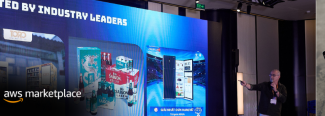
Migrating Your Microsoft Windows Workloads to AWS: What You Need to Know

Samira Kabbour
CMO
Let’s talk about why customers are choosing AWS specifically for Microsoft workloads. There are several hyperscale cloud providers available in the market today including Microsoft themselves (Azure). But when it comes to why customers are primarily choosing AWS for these workloads, it really comes down to a few key factors as discussed below.
Why AWS for Microsoft Workloads
- The Most Experience: AWS has been running Windows workloads since the very beginning of their platform. So with 10+ years of experience and hundreds of thousands of customers, there is just no competing offering that can come close to AWS’ experience doing this.
- Growth of Windows Workloads on AWS: According to AWS, between 2015 and 2018, there was a 400% growth of Windows workloads on AWS including for Amazon Elastic Compute Cloud (Amazon EC2) and for Windows Server. This is incredible growth in a short period of time and interestingly this growth eclipses even the growth of Linux workloads on AWS. We continue to see a massive uptake of Windows workloads on AWS.
- Global Reach and High Availability: AWS has more Availability Zones (AZs) and regions globally. A big differentiator that not a lot of people are not aware of and that separates AWS from the other cloud computing platforms out there, is that AWS has true availability zones spanning 20 geographic regions.
- Customer Obsession & Innovation: AWS currently offers 140+ services and one of the company’s core values is taking customer and partner feedback very seriously. As we at Mission and our customers engage with Amazon to build out their workloads on AWS, we have personally seen many instances where Amazon incorporated feedback, resulting in real progress and continual innovation.
- 50+ Compliance Certifications: AWS has the deepest set of compliance certification for hyperscale cloud. There are 50+ certifications such as HIPAA, ITAR, FISMA, and so on.
- Total Cost of Ownership (TCO): From a TCO perspective, it’s going to be hard to beat AWS. They’ve never raised prices and have offered 61 major price reductions since 2006. So we are constantly working with customers to take advantage of new capabilities that Amazon offers for cost optimization. It’s above and beyond just price reduction and having the best price point. AWS provides a lot of levers that you can push and pull to really optimize your environment, reduce your cost, and get the best TCO.
- Continuous Innovation of Windows Offerings: AWS has introduced dozens of major innovation points for Windows workloads over the past 10 years including Windows, Windows Server, SQL Server, .Net, app modernization and much more. There are 143 instance types and 37 instance families for EC2 and 60 different AMIs available for Windows workloads. So they have a very deep capability set for Windows and a jump start over the other public clouds out there. In fact, AWS hosts almost twice as many Windows server instances in the cloud than even Microsoft does!
Migration Options
So, recognizing that AWS is unbeatable when it comes to Windows workloads, let’s consider some different migration options:
- Lift and Shift: This option entails moving from your on-premise environment up into the cloud with little to no optimization or modification. That does get you onto an AWS operational model but definitely doesn’t give you the whole benefit of going to the cloud. In fact, in many cases, it might not be the right choice. It really does depend on your organization’s needs.
- Optimization: Once you are in the AWS environment, you can right-size. In an on-premise environment, you are building out your capacity based on expected peak demand. But in the cloud, you are able to align your resources with demand and you are able to do it on-demand. So right-sizing, and implementing auto-scaling and elasticity are the first stage of optimization. Using things like Reserved Instances (RIs) to save and then using managed services like Relational Database Service (RDS) rather than running your own SQL server on EC2 instance enable you to then get rid of the burden of maintaining your license. The licensing is built right into your EC2 cost for Windows and SQL server cost for RDS.
- Modernize and Refactor: This can be funded by the cost-saving you are already realizing from the previous optimization steps. You can move to containers, serverless where possible and practical, and leverage even more managed services.
Next we get to re-hosting, re-platforming and re-factoring based on your business strategy. AWS also recommends you consider your business drivers, so that the strategy for re-hosting, re-platforming and re-factoring align very closely with your ‘lift and shift’ optimization steps.
If you are going to re-host and get into the cloud in a lightweight way, you get deep familiarity, full control, and reliability. You are not changing a lot but you are getting some of the initial administration experience with AWS. You can get full control over the environment and you can have full access to all the capabilities of SQL Server.
But once you are there, if your business driver changes to getting more optimized architecture, you can re-platform. That involves using things like the Elastic Beanstalk and Directory Service, and you can get a lot more automated patching and backups resulting in improved high availability. And then full re-factoring, where you finally start realizing the full benefits of public cloud, like integration with cloud ecosystem and major benefits to TCO. Licensing becomes a lot more transparent and on-demand. And you have a lot of access to migration tools and services with AWS.
SQL Server on AWS Exhibited 2X+ Better Price/ Performance than Azure
Let’s discuss a specific use case here about SQL Server. We work a lot with the customers that have large SQL server workloads. They ask us whether SQL Servers work better on Azure or AWS. An independent research firm, ZK Research, did an extensive study in 2018 on performance and TCO for SQL Server on both AWS and Azure, and they discovered two findings..
First, they compared based on cost per billion transactions per month. This is a kind of measure of the cost per performance. On AWS, the price-performance is a little over 2x compared to Azure.
Second, they compared based on performance benefits. Many people think that instance types across different clouds that look the same are actually the same, but they really are not. This is a common misconception. When you benchmark and compare the actual performance of different instance sizes that price-performance gap is even greater. So, if you look at AWS’ equivalent instance size compared to an Azure instance, you are actually getting near 3x performance improvement.
How Renova Cloud Can Help
The time to take action is now. End of support is coming and in some cases, it has come, for several Windows workloads. SQL Server 2008 reached End of Life (EOL) in July 2019 and Windows Server 2008 will be reaching EOL in January 2020.
Renova Cloud can work with you to upgrade and modernize your Windows Workloads, and help you work with any licensing ramifications in doing so. Reach out to us if you have any questions about migrating to the newest MS software versions or if you need any assistance with your cloud journey.



